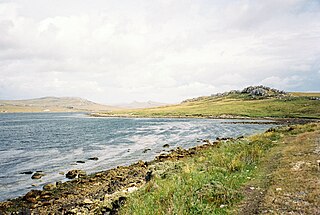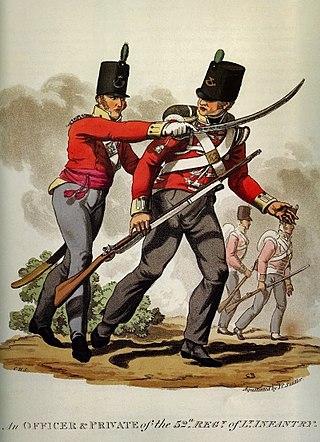Related Research Articles

Dragoons were originally a class of mounted infantry, who used horses for mobility, but dismounted to fight on foot. From the early 17th century onward, dragoons were increasingly also employed as conventional cavalry and trained for combat with swords and firearms from horseback. While their use goes back to the late 16th century, dragoon regiments were established in most European armies during the 17th and early 18th centuries; they provided greater mobility than regular infantry but were far less expensive than cavalry.

The Royal Scots Greys was a cavalry regiment of the British Army from 1707 until 1971, when they amalgamated with the 3rd Carabiniers to form the Royal Scots Dragoon Guards.

The Battle of Mount Harriet was an engagement of the Falklands War, which took place on the night of 11/12 June 1982 between British and Argentine forces. It was one of three battles in a Brigade-size operation all on the same night, the other two being the Battle of Mount Longdon and the Battle of Two Sisters.
The Battle of Two Sisters was an engagement of the Falklands War during the British advance towards the capital, Port Stanley. It took place from 11 to 12 June 1982 and was one of three battles in a Brigade-size operation all on the same night, the other two being the Battle of Mount Longdon and the Battle of Mount Harriet. It was fought mainly between an assaulting British force consisting of Royal Marines of 45 Commando and an Argentine Company drawn from 4th Infantry Regiment.
The Battle of Wireless Ridge was an engagement of the Falklands War which took place on the night from 13 to 14 June 1982, between British and Argentine forces during the advance towards the Argentine-occupied capital of the Falkland Islands, Port Stanley.

The Battle of Mount Longdon was a battle fought between the British 3rd Battalion, Parachute Regiment and elements of the Argentine 7th Infantry Regiment on 11–12 June 1982, towards the end of the Falklands War. It was one of three engagements in a Brigade-size operation that night, along with the Battle of Mount Harriet and the Battle of Two Sisters. A mixture of hand-to-hand fighting and ranged combat resulted in the British occupying this key position around the Argentine garrison at Port Stanley. The battle ended in a British victory.

The Battle of Mount Tumbledown was an engagement during the Falklands War. The engagement was an attack by the British Army and the Royal Marines on the heights overlooking Stanley, the Falkland Islands capital. Mount Tumbledown, Mount William and Sapper Hill lie west of the capital. Due to their proximity to the capital, they were of strategic importance during the 1982 War. They were held by the Argentine 5th Naval Infantry Battalion, a reinforced, cold weather trained and equipped Marine battalion.

The 2nd Cavalry Regiment, also known as the 2nd Dragoons, is an active Stryker infantry and cavalry regiment of the United States Army. The Second Cavalry Regiment is a unit of the United States Army Europe and Africa, with its garrison at the Rose Barracks in Vilseck, Germany. It can trace its lineage back to the early part of the 19th century.
"Garryowen" is an Irish tune for a jig dance. It has become well known as a marching tune in Commonwealth and American military units, most famously George Armstrong Custer's 7th Cavalry Regiment.

The 4th Princess Louise Dragoon Guards is an inactive armoured regiment of the Canadian Militia / Canadian Army. It is currently on the Supplementary Order of Battle.

The United States Cavalry, or U.S. Cavalry, was the designation of the mounted force of the United States Army. The United States Cavalry was formally created by an act of Congress on 3 August 1861 and ceased as a distinct Army branch in 1942. The name "cavalry" continues to be used as a designation for various specific United States Army formations and functions.

The 3rd Cavalry Regiment, formerly 3rd Armored Cavalry Regiment is a regiment of the United States Army currently stationed at Fort Cavazos, Texas.

The 1st Cavalry Regiment is a United States Army regiment that has its antecedents in the early 19th century in the formation of the United States Regiment of Dragoons. To this day, the unit's special designation is "First Regiment of Dragoons". While they were the First Regiment of Dragoons another unit designated the 1st Cavalry Regiment was formed in 1855 and in 1861 was re-designated as the 4th Cavalry Regiment. The First Dragoons became the 1st Cavalry Regiment since they were the oldest mounted regiment.

The Battle of Pichincha took place on 24 May 1822, on the slopes of the Pichincha volcano, 3,500 meters above sea-level, right next to the city of Quito, in modern Ecuador.

The Coalition forces of the Napoleonic Wars were composed of Napoleon Bonaparte's enemies: the United Kingdom, the Austrian Empire, Kingdom of Prussia, Kingdom of Spain, Kingdom of Naples, Kingdom of Sicily, Kingdom of Sardinia, Dutch Republic, Russian Empire, the Ottoman Empire, Kingdom of Portugal, Kingdom of Sweden, and various German and Italian states at differing times in the wars. At their height, the Coalition could field formidable combined forces of about 1,740,000 strong. This outnumbered the 1.1 million French soldiers. The breakdown of the more active armies are: Austria, 570,000; Britain, 250,000; Prussia, 300,000; and Russia, 600,000.

The voltigeurs were French military skirmish units created in 1804 by Emperor Napoleon I. They replaced the second company of fusiliers in each existing infantry battalion.

Armoured reconnaissance is the combination of terrestrial reconnaissance with armoured warfare by soldiers using tanks and wheeled or tracked armoured reconnaissance vehicles. While the mission of reconnaissance is to gather intelligence about the enemy with the use of reconnaissance vehicles, armoured reconnaissance adds the ability to fight for information, and to have an effect on and to shape the enemy through the performance of traditional armoured tasks.
The Battle of Mount Kent was a series of engagements during the Falklands War, primarily between British and Argentine special forces.
The Clare's Regiment, later known as Clare's Dragoons, was initially named O'Brien's Regiment after its originator Daniel O'Brien, 3rd Viscount Clare raised a mounted dragoon regiment during the Jacobite war. When Clare's Dragoons left Limerick with the Flight of the Wild Geese they became a regiment of infantry. Clare's Dragoons remained loyal to the dethroned James II of England and fought against the army of William III of England, during the Williamite War in Ireland.

The Royal Sardinian Army was the army of the Duchy of Savoy and then of the Kingdom of Sardinia, which was active from 1416 until it became the Royal Italian Army on 4 May 1861.
References
- Irish Com-all-ye's compiled and arranged by Manus O'Conor, New York: L. Lipkind, 1901, page 83.
- My Pious friends and Drunken Companions and More Pious Friends and Drunken Companions, songs and ballads of convivialty, collected by Frank Shay, Dover Book of Humor, 1961, originally two books from 1927 and 1928.
- Irish Drinking Songs by the McCaffrey Folk Singers, 2002, Time Music International Ltd.